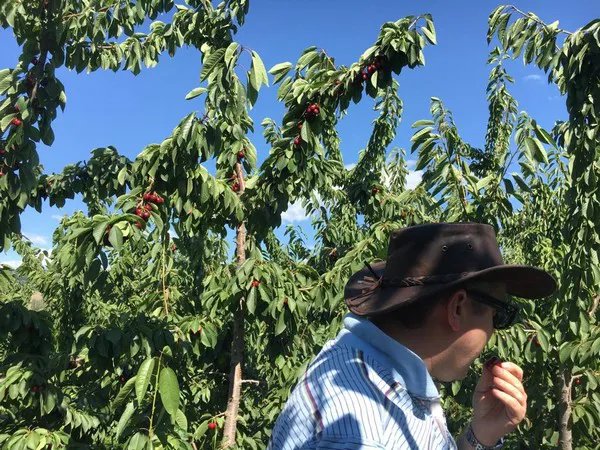Back in the 1990s, fresh produce exports from North America to Europe were significant, as the USA and Mexico together were able to supply produce almost year-round, something Europe couldn’t do. Frenchman Thierry Delapre saw an opportunity and emigrated from France to California in 1993 to start an export business that was fully dedicated to fulfilling Europe’s year-round demand for produce.
“Initially, we started with berries,” says Rob Borley, UK Manager for AMS Export. “Strawberries were making their way over from North America to Europe in large quantities at the time. Soon, the portfolio expanded with blackberries and blueberries, but also asparagus, grapes, cherries, and other stone fruit varieties.” Due to AMS Export’s close proximity to Los Angeles, the company specialized in exporting produce from Mexico, California, and Canada. “We are strategically located near key growing areas with produce from Mexico crossing the border in Nogales, Arizona. In addition, we’re close to the Central Valley, the main growing region for fresh produce in the United States and most air space is available out of the airports of Los Angeles and San Francisco, both relatively close to the company’s office and growing regions.
While these were key factors to successfully export fresh produce to Europe, things changed in the early 2000s when Europe’s demand for berries from North America started declining. “Berry growers in Spain, the UK, Morocco, and Egypt invested in new berry varieties and started growing under cover,” said Borley. The migration from growing outdoors to indoors allowed them to extend their seasons, reducing the need to bring berries in from overseas.

Table grape exports knocked out
What did this mean for AMS Export? “Well, we moved into different products,” said Borley. At the time, there was very good European demand for table grapes. The Mexican season would kick off in April and May while production in Europe wouldn’t pick up steam until July, followed by Greece in September and then California in the fall. “At the time, North America’s grapes were able to fill a gap in the European market with Mexico offering grapes in spring and late-season grapes from California being available in the fall.” Export volumes were strong until about 2008. That’s when the decline set in as Europe was able to source from regions with a closer proximity.
“Egyptian and Moroccan grape exports to Europe competed for the same window as the Mexican.” Soon after, Greece and Spain started planting similar varieties and provided the European market with table grapes during California’s season. “These four countries knocked out the window for Californian exports altogether,” said Borley.
Renewed interest for Mexican grapes
About 15 years ago, table grape exports from the USA to Europe dried up. Mexico continued, but exports were limited to Black varieties that mature late in Europe. Then things took an unexpected turn. “For the past eight years, many new grape varieties have been developed by breeders like IFG, and Sun World. While these varieties are grown around the world, some countries are quicker to make the transition to new varieties than others. Mexico for example has transitioned to new varieties fairly quickly while Egypt and Spain haven’t caught up yet,” said Borley.
“Some retailers saw their grape sales decline during the shoulders of the season in May and June, but offering new varieties has resulted in an uptick in sales again. With consumers increasingly looking for newer varieties, Mexico has been able to fill the gap from Egypt and Spain in spring and as a result, there has been renewed interest for Mexican grapes since 2015.
Cherries
Cherries also used to be a key export product. Mexico doesn’t grow cherries due to its hot climate, but between late April and September, California, Washington state, and Canada offer a non-stop supply. Over the years, cherries from these growing regions have been replaced with product from Spain, Italy, and to some extent UK and Greece. When cherry exports to Europe declined, North American growers found a lucrative market in Asia.
“However, when the trade war with China started and duties increased significantly, American growers started focusing on the domestic market,” Borley shared. “It’s a lot less risky and less complicated to sell domestically. While exports of USA cherries to Europe have become almost non-existent, there is still room for Canadian cherries to Europe due to a free trade agreement between Canada and the European Union. Today, AMS Export’s cherry exports are limited to shipments from Canada and specialty varieties like Sequoia® from the USA.
While Spain has been able to largely fulfill Europe’s demand for cherries, food regulations are another reason for the decline in exports. “North America and Europe have different regulations such as MRL requirements and Europe is very restrictive. To be able to export cherries to Europe, we are limited to certain growers in certain countries,” commented Borley. Finding growers that comply with European regulations is very difficult, in particular in the state of Washington. As a result, the August export window is pretty much out of the question.
 Rob Borley in a Canadian cherry orchard.
Rob Borley in a Canadian cherry orchard.
Sweet potatoes
One of the few products that is still heavily exported from North America to Europe is sweet potatoes. There is good demand for sweet potatoes from North Carolina as the variety and quality from the East Coast state is very much liked by clients in Europe. In addition, the curing and storage techniques allow for year-round availability. “However, from June until October, when North Carolina’s sweet potatoes are older, more quality issues present themselves.” In recent years, Egypt’s sweet potato production has increased and while the country is theoretically able to replace North America’s product in spring and summer, the Beauregard variety is generally disliked by European consumers. Even though people don’t like it, Egypt’s production offers a downward pressure on sweet potato pricing and makes North American product uncompetitive in Europe. While the quality of Egyptian sweet potatoes can’t meet that of North Carolina sweet potatoes, Borley believes Egypt offers many opportunities.
“We have started a partnership with an Egyptian sweet potato grower and a grower from North Carolina to grow sweet potatoes in Egypt’s desert region.” While most of Egypt’s sweet potatoes are grown along the Nile, the desert region will offer quality similar to a California-grown sweet potato. “It’s not our goal to compete with North America. Instead, we will be complementing North America’s window of availability and avoid quality issues later in the season.”
 Sweet potato field.
Sweet potato field.
Shifting gears
These developments have forced AMS Export to shift focus in terms of origins as well as products. “We started with berries and asparagus, then added grapes, cherries, and other stone fruit varieties. When the Mexican grape business fell away, we started working with grape growers in India and helped them look at new varieties. We managed to persuade Indian growers to modernize their production techniques and now we are importing grapes from India into Canada.”
About ten years ago, AMS Export thought they would never ship a box of Mexican grapes to Europe again, but the trend of new varieties has come forward and revived the interest for Mexican grapes.
Carbon footprint
More recently, there has been a change in attitude towards air freight, which has heavily impacted the company’s business. “However, what many people don’t know is that the carbon footprint of air freight produce is a fraction of the carbon footprint of locally produced chicken. Let’s not even take into account beef as that’s off the scale. Retailers still put beef and chicken on the shelf, but don’t want to offer airfreight produce while produce is just filling up space on passenger planes that are flying anyways.”
“Taking everything into account, I believe things will keep going in cycles and opportunities will continue to open and close,” finished Borley.
 For more information:
For more information:
Rob Borley
AMS Export
[email protected]
www.ams-export.com
